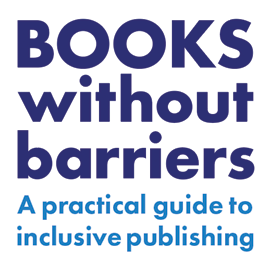
05/05/2023
A new practical guide to inclusive publishing, Books without barriers, has been developed to support publishers in providing equal access to reading.
Books without barriers: a practical guide to inclusive publishing was launched at the Institute of Professional Editors (IPEd) conference on 4 May. The guide was written by members of IPEd’s Accessibility Initiative Working Party (AIWP) and co-published with the Australian Publishers Association, with funding from the Copyright Agency Cultural Fund.
Explaining the barriers to reading
Books without barriers explains the many ways in which books can be experienced. It outlines the barriers to reading that people with print disability may experience if their needs are not supported, and describes how to avoid creating these barriers at each stage of the publishing process.
The guide is written in four parts:
- Planning for inclusive publishing: the diverse ways in which the audience reads, developing an accessibility policy for publishers, and planning the publishing workflow
- Developing content: writing and editing, creating accessible tables, considerations for mathematics and science, and considerations for children’s books
- Describing images and tables: how to write image descriptions, the steps involved in drafting them, and examples of descriptions for different types of illustration
- Producing accessible books: design, digital formats, audiobooks, and testing and reviewing for quality assurance.
The appendices include a style sheet template and a glossary.
Books without barriers is available as a free download from the IPEd and APA websites in accessible Word and PDF formats.
The role of editors
Editors have an important part to play in creating reading materials that are designed from inception to be accessible to everyone. Considering the needs of readers with print disability requires thinking beyond reading as a visual activity. Editors must also consider whether content can be perceived and understood when it is accessed by touch and hearing, not just by sight.
The writers of Books without barriers hope that the advice provided in the guide will help transform the way editors think about editing and support them in the transition to more inclusive publishing practices.
The role of everyone in publishing
Julie Burland, President of the Australian Publishers Association, said of the new resource:
‘Publishers understand the importance of ensuring that everyone has equal access to reading materials, whether for information or pleasure. However, many texts are still partly or wholly inaccessible to people with disability, making it difficult or impossible for some readers to engage with them.
Irrespective of your part in the publishing process, Books without barriers will help you understand the importance of accessibility and equip you with the knowledge and skills needed to create and edit accessible publications.
The Australian Publishers Association, alongside editors in Australia and Aotearoa New Zealand, are excited to embrace this positive change. We hope that you find this guide a valuable resource in our collective efforts to make the world more inclusive.’
Download Books without barriers
Learn more about Books without barriers and download a copy here. Members can find more resources to support Inclusive Publishing, including further training guides, in our Member Resources section.